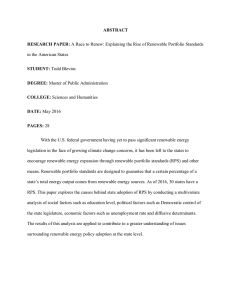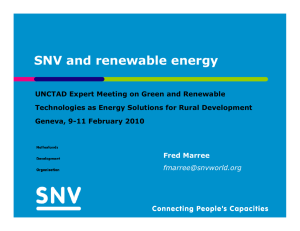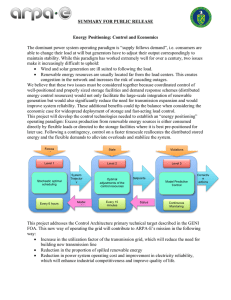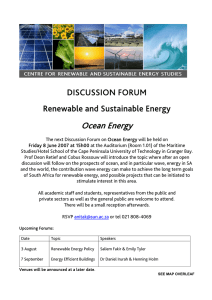Renewable Energy Companies Prepare for Rising Tide of Demand
advertisement
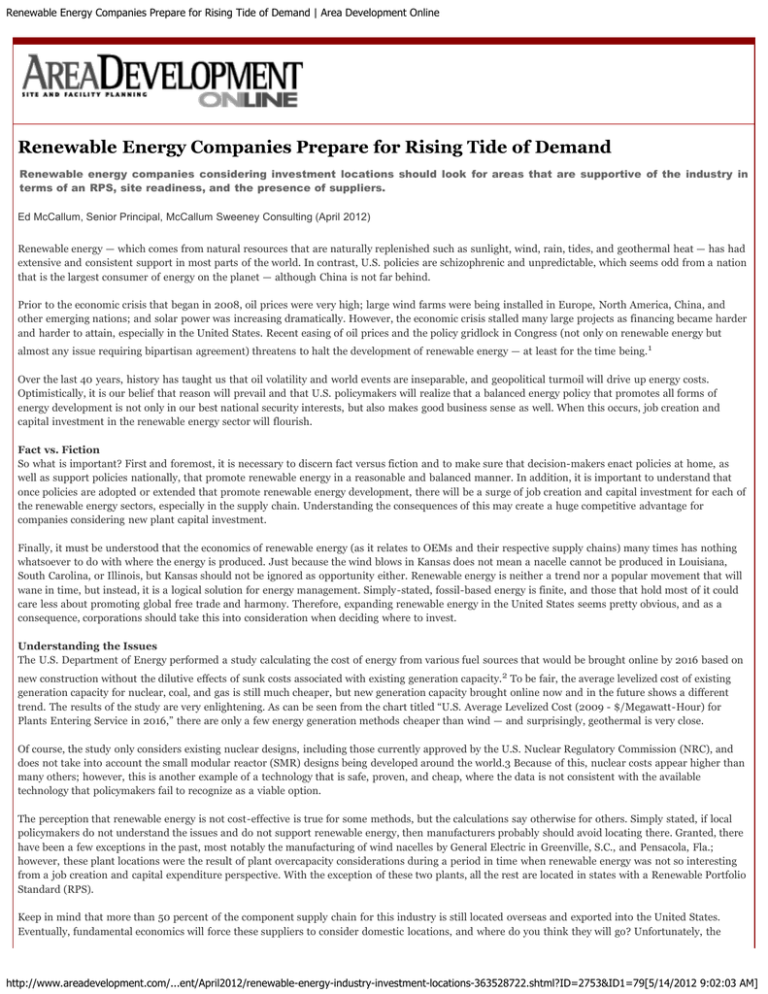
Renewable Energy Companies Prepare for Rising Tide of Demand | Area Development Online Renewable Energy Companies Prepare for Rising Tide of Demand Renewable energy companies considering investment locations should look for areas that are supportive of the industry in terms of an RPS, site readiness, and the presence of suppliers. Ed McCallum, Senior Principal, McCallum Sweeney Consulting (April 2012) Renewable energy — which comes from natural resources that are naturally replenished such as sunlight, wind, rain, tides, and geothermal heat — has had extensive and consistent support in most parts of the world. In contrast, U.S. policies are schizophrenic and unpredictable, which seems odd from a nation that is the largest consumer of energy on the planet — although China is not far behind. Prior to the economic crisis that began in 2008, oil prices were very high; large wind farms were being installed in Europe, North America, China, and other emerging nations; and solar power was increasing dramatically. However, the economic crisis stalled many large projects as financing became harder and harder to attain, especially in the United States. Recent easing of oil prices and the policy gridlock in Congress (not only on renewable energy but almost any issue requiring bipartisan agreement) threatens to halt the development of renewable energy — at least for the time being. 1 Over the last 40 years, history has taught us that oil volatility and world events are inseparable, and geopolitical turmoil will drive up energy costs. Optimistically, it is our belief that reason will prevail and that U.S. policymakers will realize that a balanced energy policy that promotes all forms of energy development is not only in our best national security interests, but also makes good business sense as well. When this occurs, job creation and capital investment in the renewable energy sector will flourish. Fact vs. Fiction So what is important? First and foremost, it is necessary to discern fact versus fiction and to make sure that decision-makers enact policies at home, as well as support policies nationally, that promote renewable energy in a reasonable and balanced manner. In addition, it is important to understand that once policies are adopted or extended that promote renewable energy development, there will be a surge of job creation and capital investment for each of the renewable energy sectors, especially in the supply chain. Understanding the consequences of this may create a huge competitive advantage for companies considering new plant capital investment. Finally, it must be understood that the economics of renewable energy (as it relates to OEMs and their respective supply chains) many times has nothing whatsoever to do with where the energy is produced. Just because the wind blows in Kansas does not mean a nacelle cannot be produced in Louisiana, South Carolina, or Illinois, but Kansas should not be ignored as opportunity either. Renewable energy is neither a trend nor a popular movement that will wane in time, but instead, it is a logical solution for energy management. Simply-stated, fossil-based energy is finite, and those that hold most of it could care less about promoting global free trade and harmony. Therefore, expanding renewable energy in the United States seems pretty obvious, and as a consequence, corporations should take this into consideration when deciding where to invest. Understanding the Issues The U.S. Department of Energy performed a study calculating the cost of energy from various fuel sources that would be brought online by 2016 based on new construction without the dilutive effects of sunk costs associated with existing generation capacity.2 To be fair, the average levelized cost of existing generation capacity for nuclear, coal, and gas is still much cheaper, but new generation capacity brought online now and in the future shows a different trend. The results of the study are very enlightening. As can be seen from the chart titled “U.S. Average Levelized Cost (2009 - $/Megawatt-Hour) for Plants Entering Service in 2016,” there are only a few energy generation methods cheaper than wind — and surprisingly, geothermal is very close. Of course, the study only considers existing nuclear designs, including those currently approved by the U.S. Nuclear Regulatory Commission (NRC), and does not take into account the small modular reactor (SMR) designs being developed around the world.3 Because of this, nuclear costs appear higher than many others; however, this is another example of a technology that is safe, proven, and cheap, where the data is not consistent with the available technology that policymakers fail to recognize as a viable option. The perception that renewable energy is not cost-effective is true for some methods, but the calculations say otherwise for others. Simply stated, if local policymakers do not understand the issues and do not support renewable energy, then manufacturers probably should avoid locating there. Granted, there have been a few exceptions in the past, most notably the manufacturing of wind nacelles by General Electric in Greenville, S.C., and Pensacola, Fla.; however, these plant locations were the result of plant overcapacity considerations during a period in time when renewable energy was not so interesting from a job creation and capital expenditure perspective. With the exception of these two plants, all the rest are located in states with a Renewable Portfolio Standard (RPS). Keep in mind that more than 50 percent of the component supply chain for this industry is still located overseas and exported into the United States. Eventually, fundamental economics will force these suppliers to consider domestic locations, and where do you think they will go? Unfortunately, the http://www.areadevelopment.com/...ent/April2012/renewable-energy-industry-investment-locations-363528722.shtml?ID=2753&ID1=79[5/14/2012 9:02:03 AM] Renewable Energy Companies Prepare for Rising Tide of Demand | Area Development Online Southeast States, through their lack of an RPS, are creating disincentives for this industry that will haunt them in the future. This is unfortunate, especially in light of the fact that offshore wind is showing much promise and these states have a competitive business climate. When the Economic Tide Turns Readiness Has Value At the risk of sounding redundant, states without an RPS should be aware that unless there are powerful incentives that make a location in non-RPS states a reasonable option, the states without an RPS are questionable location candidates. Those states should probably be eliminated from consideration for this factor alone — much like the right-to-work screen used by manufacturers in the past. This lack of policy commitment is important. Keep in mind that enacting an RPS is usually not as simple as the governor calling for a special session and requesting the legislature to adopt this new policy on a moment’s notice. There are many moving parts to an RPS that affect companies, utilities, municipalities, and the fiscal balance of various revenue programs throughout the state, so agreeing on what makes sense usually takes time. Although there may be exceptions, by and large, if an RPS does not exist, it cannot be created in a meaningful way overnight. How states approach their RPS should be a sign to companies on how they are going to approach the sector overall. Legislative readiness is not the only important factor for renewable energy manufacturers. Site readiness is important in this industry as well because demand is building, and there will be a flood of activity soon. This is due in part to the uncertainty surrounding the extension of the production tax credit (PTC) at the federal level, coupled with a lackluster economy. In some states, the RPS mandates that utilities produce a certain percentage of their power from renewable sources by a given date, regardless of the PTC or the economy. As a consequence, while many projects are either stalled or have been cancelled, the demand for power has not. It is highly unlikely that the PTC will not be renewed at some point, and when it is renewed and the economy improves, there will be a flurry of activity to build renewable energy capacity to meet this pent-up demand. While a feed-in tariff is not commonly used in the United States, it is in Canada. The recent feed-in tariff enacted in Ontario — along with specific local content requirements — spurred a high level of activity and demonstrates what happens when demand is created. Perhaps the United States could learn a few things from our neighbors to the north by requiring local content requirements, instead of importing more than 50 percent of the component parts used in renewable energy. Companies should be prepared to educate candidate communities and states on the importance of these concepts, and in the absence of interest and a sympathetic ear, consider the locations that already have an understanding of the renewable energy sector. Supply Chain at Home The majority of renewable energy components coming from outside the United States makes a lot of sense if you think about it. The unreliability of the U.S. domestic renewable energy policies makes it almost impossible for suppliers, particularly those that involve casting and machining, to commit to a long-term strategy in the United States, even though many of the OEMs have. Typically, the capital expense for these industries is equal to or greater than those of the OEMs they supply. Making a long-term investment into the states is only required when there is domestic competition, which unfortunately currently does not exist. It is ironic that many of the displaced workers in the automotive industry, as well as several of the distressed suppliers, could provide the skills and expertise to supply at least some of the components for this industry. In fact, where the automotive suppliers are currently located reflects closely where the renewable energy supplier base would most likely be situated. Unfortunately, U.S. domestic policies regarding not only renewable energy, but also local content requirements and trade balance, are working against us — at least in the short term. It is our belief that eventually this will be sorted out, and there will be renewed interest for investment into the United States. When this occurs, look to the communities and states that have ready sites, programs, and training to support your needs. In addition to renewable energy production, make sure that there is an appreciation and understanding of other opportunities, such as smart grid technology. One in particular that we have had recent experience with is energy storage technology. It is an area that has been overlooked, and judging from the lukewarm response we received from several candidate states, way underappreciated. Nevertheless, it shows a tremendous amount of promise for the power grid — with or without renewable energy. Solving the energy storage problem would greatly enhance the cost-effectiveness and efficiency of renewable energy technologies. Most utilities, if given the choice of building additional base load power generation capacity or supplemental power augmentation, would reluctantly consider supplemental power augmentation with peaker units, pump storage facilities, or other power sources during peak energy demand. Why are they reluctant? Because both baseand peak-load power generation are very, very expensive. In contrast, spending hundreds of millions of dollars for a peak demand power source compared to tens of millions for energy storage is not a difficult decision — especially if the storage solution is completely scalable, reliable, and efficient. States and communities that understand the whole spectrum of renewable energy will naturally set themselves apart from the competition when a company is looking to select a location for their new facility. Recognizing the Opportunity If you are responsible for selecting the location of the next manufacturing plant for your company, consider the following advice. Inquire into the willingness and interest of elected officials to create an RPS if the state does not already have one. If the state does have a RPS, ensure that elected officials are up to date on the industry and why it is important to either create, maintain, or strengthen the RPS. If they do not understand and support your industry now, what is the probability that they will in the future? Second, make sure that the communities you investigate have shovel-ready sites or buildings that are free of problematic schedule constraints. You cannot meet deadlines or deliver product in a timely manner if you have no idea when permits can be obtained or when infrastructure will be brought to your site. Third, investigate the existing supply chain and ascertain why suppliers are either present or absent. A comprehensive incentive policy that supports the http://www.areadevelopment.com/...ent/April2012/renewable-energy-industry-investment-locations-363528722.shtml?ID=2753&ID1=79[5/14/2012 9:02:03 AM] Renewable Energy Companies Prepare for Rising Tide of Demand | Area Development Online entire industry is important to entice suppliers to locate and create clusters. These are important items to consider for a renewable energy company looking to invest capital in a new location and are fundamental building blocks to building a successful enterprise. Once these factors have been addressed, the rest is just normal site selection due diligence. 1. The American Recovery and Reinvestment Act of 2009 (H.R. 1) allows taxpayers eligible for the federal renewable electricity production tax credit (PTC) to take the federal business energy investment tax credit (ITC) or to receive a grant from the U.S. Treasury Department instead of taking the PTC for new installations. The grant is only available to systems where construction began prior to December 31, 2011. The new law also allows taxpayers eligible for the business ITC to receive a grant from the U.S. Treasury Department instead of taking the business ITC for new installations. The Treasury Department issued Notice 2009-52 in June 2009, giving limited guidance on how to take the federal business energy ITC instead of the federal renewable electricity PTC. 2. Levelized cost represents the present value of the total cost of building and operating a generating plant over an assumed financial life and duty cycle, converted to equal annual payments and expressed in terms of real dollars to remove the impact of inflation. Levelized cost reflects overnight capital cost, fuel cost, fixed and variable O&M cost, financing costs, and an assumed utilization rate for each plant type. The availability of various incentives including state or federal tax credits can also impact the calculation of levelized cost. The values shown in the tables do not incorporate any such incentives. 3. A 2009 assessment by the International Atomic Energy Agency under its Innovative Nuclear Power Reactors & Fuel Cycle (INPRO) program concluded that there could be 96 small modular reactors (SMRs) in operation around the world by 2030 in its “high” case, and 43 units in the “low” case, none of them in the USA. Modern small reactors for power generation are expected to have greater simplicity of design, economy of mass production, and reduced siting costs. Most are also designed for a high level of passive or inherent safety in the event of malfunction. A 2010 report by a special committee convened by the American Nuclear Society showed that many safety provisions necessary, or at least prudent, in large reactors are not necessary in the small designs forthcoming. All contents copyright © 2011 Halcyon Business Publications, Inc. http://www.areadevelopment.com/...ent/April2012/renewable-energy-industry-investment-locations-363528722.shtml?ID=2753&ID1=79[5/14/2012 9:02:03 AM]
